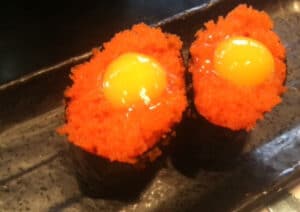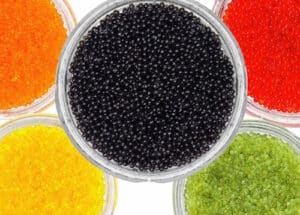Masago and Tobiko - Flavor And Texture
What are Masago And Tobiko?
Masago

Interestingly, while the capelin fish is perfectly edible and similar to sardines, it is is mostly used to for other seafood products. For example, approximately 80% of capelin is used to produce fishmeal for the farmed seafood industry and fish oil products (for those who take omega-3 supplements), while the remaining 20% is used to produce masago for diners. It is usually server with a dull-orange color, but can be colored as well.
Interestingly, another roe, called tobiko, shares a close taste to masago, and is more popular choice as it has a wild crunchiness and is considered a higher quality roe. But capelin roe is a less flexible ingredient than tobiko in sushi due to its softer texture. This has not stopped many sushi restaurants from substituting masago for tobiko though. One big difference between the two types of roe is that masago is significantly cheaper, though people do order masago sushi as it is still a tasty treat.
While tobiko is viewed as a higher quality product than masago, this has not stopped restaurants from using masago in its place to help their profits. Masago is also slightly smaller than its cousin fish egg. If you want to enjoy this wonderful food, it can be purchased on its own from sushi retailers (you can easily find it if you have a Japanese grocery store near you) to make sure you are getting the crunchy sweetness you are looking for. It is also a high quality food, and as it is low on the food chain, capelin and its roe, has very low mercury content. This is good as mercury is a concern for people with a heavy seafood diet. It is also a great source of important trace minerals such as selenium, which most people lack in their diet, and vitamin B12.
It is also a great source of high quality protein. While it may be small, masago has a high amount of protein relative to its size. A single 1-ounce (28-gram) serving of the roe contains 6 grams of high quality protein. This is about the same as one large (50-gram) chicken egg. Not bad for something relatively inexpensive with a fun texture and flavor.
Tobiko
Tobiko is one of the most prized sushi roes (as in “caviar”) in Japanese cuisine, valued as a finishing touch and garnish to rolls and is enjoyed on its own by lovers of the crunchy pop it has. This slightly sweet roe is the eggs of tropical flying fish, which are known for their ability to leap into the air at speeds of over 40 mph. Its unmistakable orange color and texture adds a nice detail to many sushi items, even the popular California roll. If you eat sushi regularly, it is a good bet you have seen and eaten this roe.
The bright hues of tobiko are in contrast to its mild taste, which is slightly sweet and salty. It is most often added to rolls not simply for its taste, but because of its consistently crunchy texture and bright appearance. There is something quite satisfying to the fun crunch of chewing these little pops of tasty goodness. Those who love tobiko most enjoy the dish as a nigiri item, placing the roe on top of sushi rice. While tobiko is prized for its use in sushi, it is a versatile ingredient in other dishes. Tobiko can be enjoyed on crackers, in omelets, or on salads for example.
The Many Colored Roe
Interestingly, it can easily be dyed with various products to create colors that catch the eye. Due to its texture, is is the commonly chosen roe for this purpose by sushi chefs. While primarily served red, you may come across numerous different styles such as:
- Red Tobiko: This is the most common type, with a natural light orange or red color. This color is often used in sushi rolls for its visual appeal.
- Black Tobiko: Colored with squid ink, black tobiko has a slightly different taste as squid ink will add some flavor and additional salt. It’s often used to create a striking visual contrast in dishes.
- Green Tobiko: This variety is flavored with wasabi or another product to taste like wasabi, which gives it a green color and a spicy kick. It’s popular among those who enjoy a bit of heat in their sushi and offers an unusual visual appeal.
- Yellow Tobiko: This type is flavored with yuzu, a type of citrus fruit more common in Asia (Japan in particular), giving it a distinctively tangy, bright, and fresh flavor. The coloring is usually from natural or artificial sources.
- Golden Tobiko: Often used for special occasions, this variety has a golden color. Sometimes it’s simply dyed, but it can also be flavored with ingredients like saffron or other unusual methods for a unique taste meant to enhance an already impressive experience.

Nutritionally, this item is loaded with protein, vitamins, and essential omega-3 fatty acids. Even though it is often used as a garnish, the omega-3s are now viewed to bu quite good for you. Furthermore, the low-calorie count and high protein content make them a guilt-free indulgence for those seeking a healthier, yet delectable, dining option.
As for sustainability, it is important for restaurants and stores to use sustainable sourcing practices. Ensuring that the tobiko you consume comes from reputable and eco-friendly fisheries is crucial for the well-being of our oceans and the continued availability of this delightful ingredient. By supporting fisheries that employ responsible harvesting methods, you can indulge in the exquisite taste and texture while doing your part to protect the environment.
